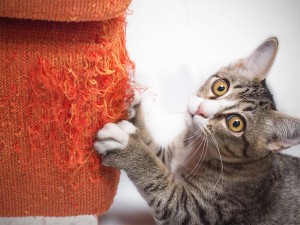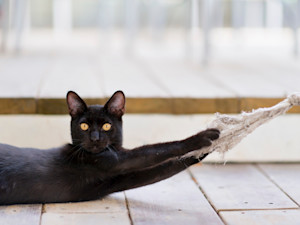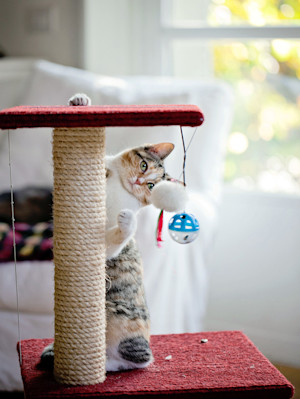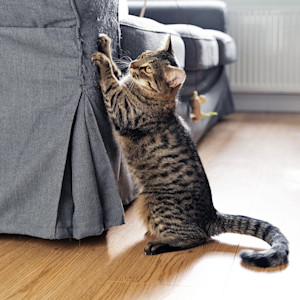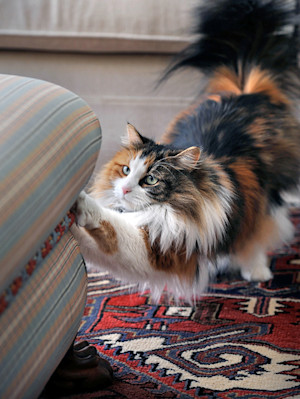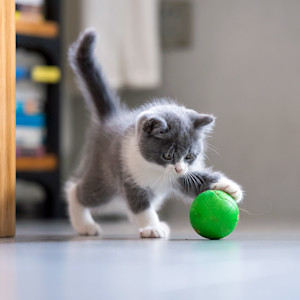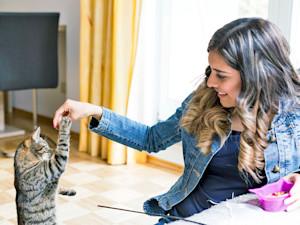
Share Article
In This Article:
Instinct Claw Health Scent Marking Stretching Play and Energy-Burning Mental Stimulation Attention-Seeking Excitement How to Stop Your Cat from Scratching Furniture
This is one of the universal frustrations about having a cat. Why must they scratch up our furniture? Don’t they realize we scrimped and saved to buy that couch, and we’d like to avoid it looking like a giant pile of shredded fabric and string?
No, they don’t. In fact, your cat probably has their own questions for you. “Doesn’t my person realize that I really need something to scratch right in this very spot? It’s where I stretch after naps. It’s the perfect place to leave a scent message for that other cat. And when I feel nervous, I like having my scent here to comfort me.”
The truth is, your cat has instinctual reasons for scratching your furniture. That doesn’t mean you have to live with it. Let’s talk about why cats need to scratch furniture and what you can do about it.

1. Instinct
The foundation of your cat’s scratching behavior is instinctual. They’ve been programmed to do this fundamental thing for all the reasons we’re about to discuss.
So, how do you stop your cat from doing something they instinctually need to do? You don’t. You can’t remove their need to scratch. The trick is to give them alternative scratching options that meet those needs just as well as your couch.
2. Claw health
Scratching helps with nail maintenance. It can dull the sharp points, keep nails from getting so long that they cause problems with walking, and help remove the sheath. Keeping your cat’s nails trimmed is a good way to meet that need, so they’re less likely to use your furniture.
But that doesn’t mean the need to scratch goes away. You’ve got to provide alternatives. Try to find a scratching post or surface that replicates what they get from scratching the furniture. Do they scratch horizontally or vertically? Do they prefer fabric, wood, rattan? Do they go for the strong, sturdy couch instead of the wobbly chair? Take these preferences into account when picking your scratcher.
3. Scent-marking
Scratching is one way cats can deposit scent and spread those pheromones around. They have scent glands in their paws. In other articles, we’ve talked a lot about how important scent is in cat communication. They use it to mark territory, letting other cats know there’s already a cat in this area.
They can gauge how recently another cat was there by how strong the scent is. Even the physical marks from scratching help cats share information. They also use scent to self-soothe. Being surrounded by their scent is comforting.
Spread scratching surfaces around the home, particularly in areas where your cat is scratching furniture. They’re telling you where they need their scent. Just give them a better option than your couch by placing a scratcher nearby.
4. Stretching
Stretching is important for cats. They often do this by reaching really high up on their scratcher and leaning into the pose. It’s common after naps, which is why they often scratch furniture near places they like to sleep.
A tall, sturdy scratching post or wall-mounted scratching mat near sleeping spots is a good alternative to furniture.
5. Play and energy-burning
Your cat may also scratch when they’re amped up, playing, and running around. Zoomies often include a pitstop at the “post” for a scratch before they take off again.
This is where a sturdy post is essential — one that can take the mid-zoomies scratch attack without falling over. Scratching posts with a heavy base, horizontal scratchers your cat can stand on as they scratch, and wall-mounted scratchers are great options that won’t wobble or fall under the strength of your cat’s scratching.
6. Mental stimulation
A bored cat is going to look for things to do. Scratching can be one of those things. While it’s not necessarily the height of cerebral activities, it’s still an instinctual behavior that can occupy a few moments.
Offering other forms of mental enrichment, like food puzzles and training, will help meet that need, too.
7. Attention-seeking
If your cat scratches the couch and you stop what you’re doing to address it, they’ve learned how to get your attention. It’s not as “criminal mastermind” as you might think. It’s as simple as, Oh, I see. That’s how I get what I need.
If you need to interrupt your cat’s scratching and clawing at the furniture, do it in a neutral way. It’s not good or bad. Just walk over, pick them up, and set them back down a few feet away. No lectures about scratching. That’s attention. Keep it neutral.
Then point them toward a nearby scratching post or other option. (We’ll talk more about this later.)
8. Excitement
Happy cats love to scratch. You’ve probably seen your cat run to their scratching spot when you excitedly say their name and head over for a petting session. That’s why it’s great to have many scratching options around, so your cat has easy access no matter where you have your petting party.
What about things to avoid? Punishment is high on the list. It adds stress, which can actually increase scratching behavior. And it will damage your relationship. It doesn’t solve the problem. It just makes more problems.
It’s also best to avoid things like anti-scratch spray. They’re often scented with things that can irritate your cat’s nose. This leads to stress and a desire to cover up that scent, which may mean even more scratching.
Declawing your cat is the biggest, most important thing to avoid at all costs. While it may solve one problem for you, it can cause many others for your cat. Declawing is the equivalent of cutting off the tip of your finger at the first knuckle. It can be very painful and cause musculoskeletal issues because it changes your cat’s posture. They’ve also lost their most important weapon. This can make them more anxious and reactive. The additional stress can cause issues much worse than scratching furniture, like spraying, fear, and having accidents in the house.
Bottom line
Cats need to scratch things. It’s an instinctual imperative that checks multiple boxes, like nail care, marking territory, and communicating with other cats.
Teaching your cat not to scratch the furniture begins with trying to figure out why they’re choosing the furniture.
Then you can provide alternatives that meet those needs.
Keep your cat’s preferences in mind, like orientation and material.
Make good things happen for your cat when they use their scratching posts and other scratchers. Reward the behavior you want, and you’ll see it happen more often.
References
“Cat Pheromones May Cause Increased Scratching; Focus on Scratching Devices | __July 2015 | Davis College News + More | Davis College | TTU.” Ttu.edu, 2015, www.depts.ttu.edu/agriculturalsciences/news/posts/2015/07/cat-pheromones-may-cause-increased-scratching-focus-on-scratching-devices.phpopens in new tab.
Cisneros, Alissa, et al. “Unwanted Scratching Behavior in Cats: Influence of Management Strategies and Cat and Owner Characteristics.” Animals, vol. 12, no. 19, 24 Sept. 2022, p. 2551, doi.org/10.3390/ani12192551, https://doi.org/10.3390/ani12192551opens in new tab.
Engrav, Charlotte. “Why Your Cat Scratches Furniture – and How to Get It to Stop.” Health News Florida, HEALTHNEWSFL, 11 July 2024, health.wusf.usf.edu/npr-health/2024-07-11/why-your-cat-scratches-furniture-and-how-to-get-it-to-stopopens in new tab.

LeeAnna Buis, CFTBS, FFCP
LeeAnna Buis has adored cats her entire life and thought she knew them inside out and sideways. But it wasn’t until she worked with a feline behavior consultant that she fully understood how incredible, complicated, and inspiring they really are. She made a career change, starting the certification process to become a behavior consultant right away. She discovered what unique, fascinating, complex creatures cats are and knew this was what she wanted to do with her life — help others on a similar journey to truly knowing, loving, and appreciating their cats.
LeeAnna earned her certification through Animal Behavior Institute, where she received the certified feline training and behavior specialist (CFTBS) designation.
Related articles
Why Does My Cat Scratch the Wall?
Well, that is a little unsettling.
![Cat playing with scratching post.]()
How to Train and Get Your Cat to Use a Scratching Post
You can stop your cat from scratching everything in sight.
![Cat scratching a couch in the living room.]()
Having This In Your Home Will Make Your Cat Scratch More, New Study Says
Plus, how to keep your kitty from destroying the couch.
![Naughty cat scratching couch at home.]()
How to Stop Cats From Scratching Furniture
Don’t they care that you saved for six months for that sofa?
![Small kitten playing with a rubber ball at home.]()
Cats Can’t Stand These Textures—They Have Very Sensitive Paws
It's not just crumpled tin foil.
![Woman training kitten at home.]()
How to Train a Kitten
Yes, it’s possible.

